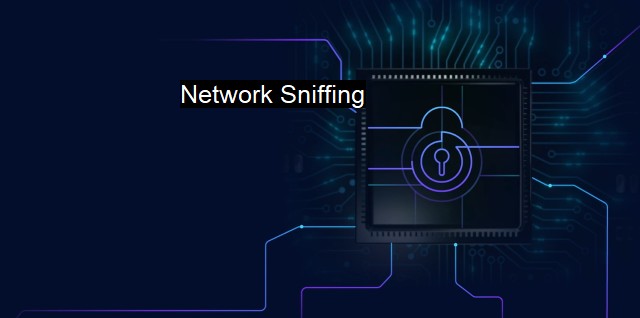What is Network Sniffing?
The Perils of Network Sniffing: A Closer Look at Cybersecurity Vulnerabilities and Countermeasures
Network sniffing, often simply referred to as ‘sniffing,’ is a set of tactics employed by cybercriminals, network administrators, and sometimes individuals involved in ethical hacking to intercept, monitor, and capture data that travels via network traffic. Emerging from a cybersecurity perspective, sniffing poses a serious threat to digital communications and transactions, highlighting the importance of strong internal network protection practices.At its core, network sniffing involves the examination of data packets that traverse a network. Data packets are essentially small batches of data that are formatted for transmission over a network, containing both control information and user data. The control information helps the network handle the packet while user data, also known as payload, is part of the message to be transmitted. By dissecting these packets, a network sniffer can "read" and interpret networking traffic, potentially gaining unauthorized access to sensitive or valuable information, such as personal identification details, credit card numbers, bank login credentials, or even classified documentation.
Network sniffing is a form of passive wiretapping that breaks the confidentiality principle of the CIA model (Confidentiality, Integrity, and Availability – three advanced pillars of information security). Unauthorized sniffing can result in severe damage, such as identity theft, financial losses, or corporate espionage.
Network sniffing is typically achieved through the use of software applications colloquially known as sniffer programs. These specialized applications allow visitors to 'listen' to network traffic by tapping network packets as they traverse between points. Certain types of sniffer programs also allow for the direct filtering and analysis of captured data. Due to their capabilities, sniffer programs, while relentlessly feared by individuals and corporations for their potential misuse, are widely utilized legally by network administrators to troubleshoot network problems and test software and devices for security breaches.
Strategies for network protection often bind to preventive measures, notably encryption and use of secure network protocols, to eliminate the susceptibility of network traffic to sniffers. For instance, an encrypted HTTP, or HTTPS, shields data packets by making them unreadable to sniffers while SSL and TLS protocols provide data integrity assurances by excluding the capturing and modifying of data.
Concurrently, organizations are extensively investing in advanced cybersecurity systems, which include antivirus, anti-malware, and intrusion detection/prevention systems (IDS/IPS), to counter sniffing attacks. Antivirus software, primarily utilized to protect against malware, broadens its potential by including signatures of common sniffer programs. With Intrusion Detection systems, signs of malicious network activities, like unusual data traffic pattern, can be observed promptly to activate relevant counteractions.
Despite network sniffing having a notorious reputation owing to its vulnerability abuse, ethical hacking, such as penetration testing, greatly essentials it to help organizations better understand their network vulnerabilities and bolster security practices. Unlike malicious hackers, ethical hackers leverage the same tools for beneficial outcomes, pinpointing weak areas and advising on remediation measures to thwart potential threats before they strike.
Today's interconnected world necessitates secure communication channels. Recognizing the risks posed by network shortcomings and malicious activities such as sniffing can facilitate enhanced methods, technologies, and policies to minimize data exposure and bolster cybersecurity. As a result, businesses and individuals alike can confidently participate fully in the dynamic digital landscape without worrying that their private, sensitive data will fall into the wrong hands.

Network Sniffing FAQs
What is network sniffing?
Network sniffing is the practice of intercepting and examining network traffic in order to obtain information about the network, such as usernames and passwords, or to detect potential security breaches.How do cybercriminals use network sniffing?
Cybercriminals can use network sniffing to intercept sensitive information being transmitted across a network, such as personal data or financial information, and then use that information for fraudulent activities.How can antivirus software help protect against network sniffing attacks?
Antivirus software can help protect against network sniffing attacks by detecting and blocking malicious software that may be used by cybercriminals to intercept network traffic. It can also detect attempts to exfiltrate sensitive data from a network and alert security administrators.What are some best practices for preventing network sniffing attacks?
To prevent network sniffing attacks, it is important to use strong encryption protocols, such as SSL/TLS, for transmitting sensitive information. It is also recommended to use strong passwords, implement firewalls, and keep software and operating systems up-to-date with the latest security patches. Regularly monitoring network traffic can also help detect any unauthorized access or suspicious activity.| | A | | | B | | | C | | | D | | | E | | | F | | | G | | | H | | | I | | | J | | | K | | | L | | | M | |
| | N | | | O | | | P | | | Q | | | R | | | S | | | T | | | U | | | V | | | W | | | X | | | Y | | | Z | |
| | 1 | | | 2 | | | 3 | | | 4 | | | 7 | | | 8 | | |||||||